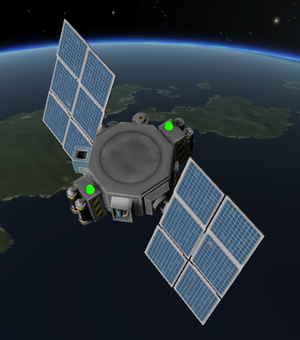Electric charge/ru
| Электроэнергия | ||
| Плотность | Нет | |
| Передаваемый | Да | |
| Tweakable | Да | |
| Drainable | Нет | |
| Способ истечения | Везде | |
| Стоимость | Нет | |
| С версии | 0.18 | |
Electric charge, also called electricity or energy, is a resource that is needed to operate various parts in the game. It is critical for unmanned spacecraft, which are generally uncontrollable without any electric charge. However, manned spacecraft usually also need some electricity, mainly for reaction wheels.
Contents
Источники
генераторы переменного тока на двигателях
| Type | Name | Output | Usage |
|---|---|---|---|
| Rocket engines | LV-T30 Liquid Fuel Engine | 7.0 e/s | 1.691 l/e |
| LV-T45 Liquid Fuel Engine | 6.0 e/s | 1.835 l/e | |
| Rockomax "Poodle" Liquid Engine | 8.0 e/s | 1.436 l/e | |
| Rockomax "Skipper" Liquid Engine | 10.0 e/s | 3.782 l/e | |
| Rockomax "Mainsail" Liquid Engine | 12.0 e/s | 7.715 l/e | |
| LV-N Atomic Rocket Motor | 5.0 e/s | 0.3055 l/e | |
| Toroidal Aerospike Rocket | 5.0 e/s | 1.828 l/e | |
| Jet engines | Basic Jet Engine | 4.0 e/s | ? |
| TurboJet Engine | 5.0 e/s | ? |
Many rocket and jet engines have alternators installed which produce electricity. The exact output varies based on throttle level, and engines not running will not produce any electricity. The adjacent table shows the engines which provide electricity, their production at full throttle and fuel usage in vacuum. Jet engines only generate electricity when supplied with intake air.
Солнечные панели
Solar panels are a lightweight source of electrical energy. However, they need direct sunlight to work, so they won't produce electricity on the night side of a planet, in the shadow of a spacecraft or during eclipses of the sun, although the craft is illuminated while in an eclipse. Due to this unreliability, it is recommended to have some energy storage as a buffer when supplying a craft solely with solar panels.
All panels except for the OX-STAT Photovoltaic Panels need to be extended using the right-click menu or action groups before they will generate energy. Unpacked solar panels are very fragile and will easily break off when colliding or experiencing atmospheric drag, so they must be retracted during liftoff, aerobraking, or atmospheric re-entry.
The energy output of solar panels depends on their orientation to Kerbol. Except for the surface-mounted OX-STAT Photovoltaic Panels, all panels will automatically pivot around one axis to face the sun as much as possible. Reorienting a vessel to manually aim the panels at the sun and eliminate shadows cast on them will also improve power generation.
Generated power will also decrease with increasing distance from Kerbol, but rather than following the real-life inverse-square law it experiences a spline curve of 3 piecewise cubics defined from 4 points:
| Distance (m) | Power | Comment |
|---|---|---|
| 0 | 10x | |
| 13,599,840,256 | 1x | Kerbin's orbit |
| 68,773,560,320 | 0.5x | Jool's semi-major axis |
| 206,000,000,000 | 0x | Almost 3x Jool's orbit |
Радиоизотопный термоэлектрический генератор
Радиоизотопный термоэлектрический генератор"PB-NUK" - постоянный и надежный источник энергии, который совсем не требует солнечного света и является намного более стойким к нагрузкам от аэродинамического сопротивления, чем солнечные батареи. К сожалению, он имеет очень непрактичную форму и значительно тяжелее, чем солнечные батареи с сопоставимым выходом электричества.
Пусковые фиксаторы
TT18-A Launch Stability Enhancers provide attached craft with 1.0 charge units per second per clamp and thus prevent running out of energy on the launch pad.
Хранение
Storing electric charge helps a craft survive longer without energy supply, deal with peak loads (like transmitting science results) or bridge time gaps when solar panels aren't usable. The following parts store energy:
- Unmanned command modules offer very low capacities and constantly consume energy.
- Manned command modules offer significant storage capacities and do not consume energy (unless when reaction wheels or SAS are used) but are relatively large and heavy.
- Batteries are small and offer high storage capacities at the same time. All have the same capacity/mass ratio of 50 g/E or 20 E/kg.
- The Probodobodyne RoveMate functions like a large low-capacity battery.
All energy storage available to a craft is fully loaded at launch.
Потребление и использование
- Unmanned command modules constantly use 1.7 or 3.0 units of electric charge per minute and can only store enough internally for a few minutes of operation.
- Reaction wheels, both the stand-alone parts and as part of command capsules, consume energy while operating.
- In career mode, antennae require large amounts of energy for a short time when they transmit science to the space center.
- Electric lights and environmental sensors use small quantities of electricity when switched on.
- Ion engines, and rover wheels require particularly large amounts of electricity to operate.
If an unmanned craft has no electric charge available, it becomes entirely nonfunctional and no parts may be operated (notably, this includes motorized solar panels which might have allowed it to recover). However, it can still be saved if another craft docks to it and supplies it with electricity, or if a kerbonaut on EVA manually extends the solar panels.
